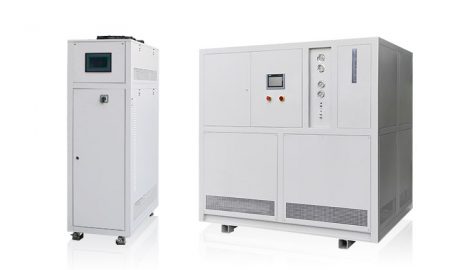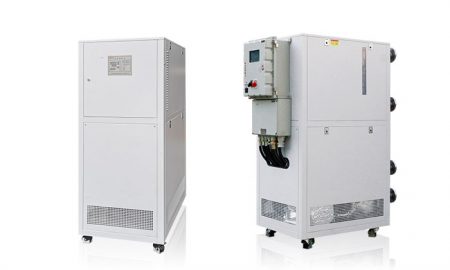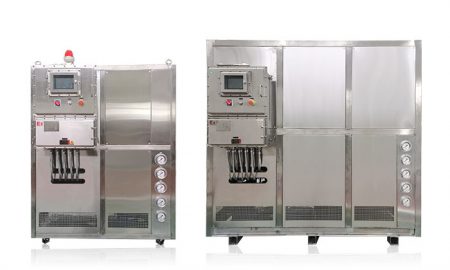Circulator Heating and Cooling Control System
Contattateci oggi stesso per la soluzione di controllo della temperatura perfetta
Circulator heating and cooling control system: an energy-saving device that uses hot and cold power cycles for industrial and commercial applications
The circulator heating and cooling control system is an energy-saving equipment that uses the principle of hot and cold power cycle. It uses the working fluid to absorb and release heat in the working environment to generate power, and converts energy into hot and cold effects. This equipment can efficiently realize energy utilization and conservation in industrial and commercial fields.
Working principle: Hot and cold cycles generate power and cold and hot effects to achieve energy conversion
The working principle of the circulator heating and cooling control system is based on the second law of thermodynamics, which is the principle that heat flows spontaneously from high-temperature areas to low-temperature areas. It achieves energy conversion through the following steps:
Heating: The working fluid absorbs heat from the low-temperature area to increase its temperature.
Expansion: The heated working medium expands due to the increase in temperature, generating pressure.
Work output: The expanded working fluid drives the moving mechanism (usually a piston, turbine, etc.) to perform work output, thereby achieving energy conversion.
Cooling: The heat is transferred from the working medium through the cooling system to reduce its temperature.
Compression: The cooled working fluid shrinks due to the decrease in temperature, producing a lower pressure.
Repeated circulation: the working fluid returns to the low temperature area again to absorb heat, and the cycle starts again.
Through the above cycle process, the circulator heating and cooling control system can not only produce power output, but also bring about cooling and heating effects, that is, realizing the functions of cooling and heating during the cycle process.

Application areas: circulator heating and cooling control systems play a variety of roles in industry and commerce
Refrigeration and air conditioning: circulator heating and cooling control system plays an important role in the field of refrigeration and air conditioning. It can provide a low-temperature environment through the heat absorption process and help meet the needs of industrial refrigeration, commercial cold chain, and indoor air conditioning.
Heat recovery and utilization: The circulator heating and cooling control system can realize energy recovery and utilization through the process of absorbing and releasing heat. In industrial production, waste heat recycling can greatly improve energy efficiency and energy conservation and emission reduction effects.
Energy conversion: The circulator heating and cooling control system can convert waste heat, low-temperature energy, etc. into power output for driving other equipment or machinery. This is of great significance for improving energy efficiency and reducing dependence on traditional energy sources.
Power generation and heating: circulator heating and cooling control systems are also widely used in the fields of power generation and heating. By utilizing the processes of heating, expansion and compression of the working fluid, it can drive a generator or provide thermal energy to meet the needs of electricity and thermal energy.
Circulator heating and cooling control system helps efficient energy utilization and environmental protection
As an energy-saving device that utilizes the principle of hot and cold power circulation, the circulator heating and cooling control system can achieve efficient utilization and recycling of energy in industrial and commercial fields. Through the diversity of its working principles and application fields, circulator heating and cooling control systems play an important role in refrigeration and air conditioning, heat recovery and utilization, energy conversion, power generation and heating. Its emergence will help improve energy efficiency and reduce dependence on traditional energy sources, while also meeting the needs of environmental protection and sustainable development.
E-mail: info@lneya.com ID WeChat: +8615251628237 WhatsApp: +86 17851209193

Sistemi di raffreddamento e riscaldamento (serie SUNDI)
Intervallo di controllo della temperatura: da -120°C a +350°C
Applicazioni: Vari reattori (microcanali, vetro, reattori con rivestimento, ecc.), sistema di distillazione o estrazione, laboratorio, università, istituto di ricerca, industria aerospaziale, automobilistica, test di semiconduttori ed elettrici, chimica, farmaceutica, petrolchimica, biochimica, medica, ospedaliera, officina di ricerca e sviluppo, aerospaziale, biologica e altre industrie.
| Intervallo di temperatura | Serie -10 ~ +150°C | Serie -25 ~ +200°C | Serie -25 ~ +300°C | Serie -45 ~ +250°C | Serie -45 ~ +300°C | Serie -60 ~ +250°C | Serie -60 ~ +300°C | Serie -70 ~ +250°C | Serie -80 ~ +250°C | Serie -90 ~ +250°C | Serie -100 ~ +100°C | -25 ~ +200°C una macchina per due reattori | -40 ~ +200°C una macchina per due reattori |
| Capacità di raffreddamento | 1,5 ~ 15kW | 1 ~ 200kW | 1 ~ 200kW | 0,45 ~ 200kW | 0,9 ~ 25kW | 0,25 ~ 60kW | 0,75 ~ 25kW | 0,4 ~ 15kW | 0,3 ~ 80kW | 0,2 ~ 80kW | 0,45 ~ 80kW | fino a 10*2kW | fino a 10*2kW |
| Nota: qualsiasi intervallo di temperatura da -150℃ a +350℃ e qualsiasi capacità di raffreddamento possono essere personalizzati. | |||||||||||||

Sistemi di raffreddamento e riscaldamento (serie WTD)
(Micro reattori a canale/tubo specializzati)
Intervallo di controllo della temperatura: da -70°C a +300°C
Design specializzato per il microcanale (piccola capacità di contenimento del liquido, forte capacità di scambio termico, elevata perdita di carico del sistema di circolazione)
| Intervallo di temperatura | -70°C ~ +300°C | -45°C ~ +250°C | -70°C ~ +200°C | ||||||
| Capacità di raffreddamento | 1,1 ~ 7,5kW | 1,5 ~ 5,5kW | 11 ~ 50kW | ||||||
| Nota: qualsiasi intervallo di temperatura da -150℃ a +350℃ e qualsiasi capacità di raffreddamento possono essere personalizzati. | |||||||||

Circolatori di raffreddamento e riscaldamento
Intervallo di controllo della temperatura: da -45°C a +250°C
Applicazioni: Vari reattori (microcanali, vetro, reattori a camicia, ecc.), sistemi di distillazione o estrazione, laboratori, università, istituti di ricerca, industria aerospaziale, chimica, farmaceutica, petrolchimica, biochimica, medica, ospedaliera, officina di ricerca e sviluppo, aerospaziale, biologica e altre industrie.
| Intervallo di temperatura | Serie -25°C ~ +200°C | Serie -45°C ~ +250°C | |||||||
| Capacità di raffreddamento | 1 ~ 15kW | 0,25 ~ 15kW | |||||||
| Nota: qualsiasi intervallo di temperatura da -150℃ a +350℃ e qualsiasi capacità di raffreddamento possono essere personalizzati. | |||||||||

Circolatori di riscaldamento
Intervallo di controllo della temperatura: Da +50°C a +300°C
Nota: la serie UC può controllare la temperatura del mezzo di trasferimento del calore. La serie UST può controllare non solo la temperatura del mezzo di trasferimento del calore, ma anche quella del materiale di reazione.
| Intervallo di temperatura | +50°C ~ +170°C (serie UC) | +50°C ~ +300°C (serie UC) | +50°C ~ +300°C (serie UST) | ||||||
| Capacità di riscaldamento | 5,5 ~ 15kW | 3,5 ~ 130kW | 3,5 ~ 95kW | ||||||
| Nota: qualsiasi intervallo di temperatura da -150℃ a +350℃ e qualsiasi capacità di raffreddamento possono essere personalizzati. | |||||||||

TCU Sistema di controllo della temperatura dei multireattori
Intervallo di controllo della temperatura: da -120°C a +250°C
Applicazioni: Vari reattori (microcanali, vetro, reattori a camicia, ecc.), sistemi di distillazione o estrazione, laboratori, università, istituti di ricerca, industria aerospaziale, chimica, farmaceutica, petrolchimica, biochimica, medica, ospedaliera, officina di ricerca e sviluppo, aerospaziale, biologica e altre industrie.
| Intervallo di temperatura | Serie -45°C ~ +250°C | Serie -120°C ~ +250°C | Sistema di controllo della temperatura personalizzato | RT+10°C ~ +135°C | |||||
| Capacità di riscaldamento | 25 ~ 80kW | 25 ~ 80kW | Personalizzato | 25 ~ 300kW | |||||
| Nota: qualsiasi intervallo di temperatura da -150℃ a +350℃ e qualsiasi capacità di raffreddamento possono essere personalizzati. | |||||||||
 LNEYA
LNEYA
 简体中文
简体中文


















































































